Interested in freezing almond milk?
Here’s the lowdown:
- You can freeze almond milk, but it separates after thawing. That makes it grainy and alters its flavor. Blending defrosted almond milk helps, but it doesn’t make it good enough to drink it plain. It works best in cooked and baked dishes.
- You can freeze it in an ice cube tray, airtight containers, or freezer bags, depending on how much you need at a time.
- Defrost your almond milk in the fridge overnight for best results.
Want the full scoop?
Read on.
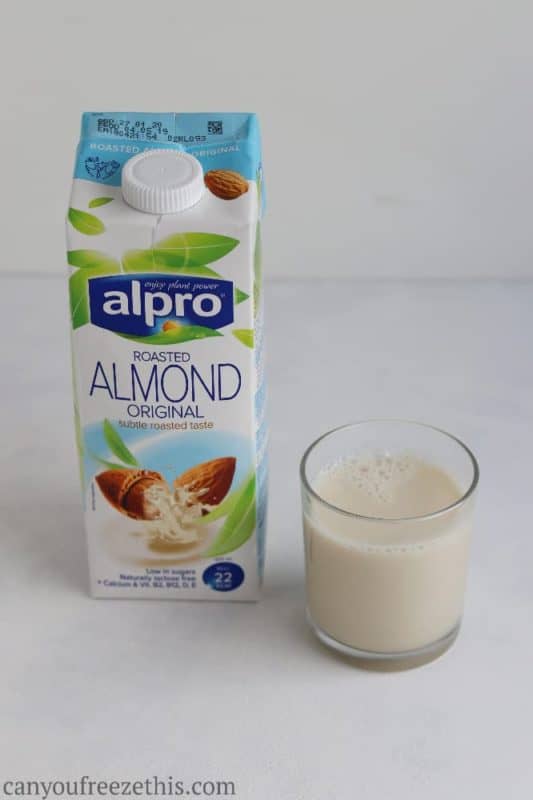
Table of Contents
- Can You Freeze Almond Milk?
- How to Freeze Almond Milk
- How to Thaw Almond Milk
- How To Use Thawed Almond Milk
- Can You Refreeze Almond Milk?
- FAQ
Can You Freeze Almond Milk?
Yes, you can freeze almond milk and freezing doesn’t affect the safety or nutritional value of almond milk, but it comes at a cost: it separates after thawing.
You can blend it to improve the texture somewhat, but it won’t be as good as fresh almond milk. Because of that, it’s best to use frozen almond milk in cooked and baked dishes.
That’s why most manufacturers (like Silk or Blue Diamond) don’t recommend freezing their almond milk.
(The same is true for freezing coconut milk.)
So it’s not because the producers want you to throw the leftovers out and go buy more of their products. Or that’s not the only reason behind that recommendation, at least.
Texture Change
The texture of almond milk changes after freezing and thawing. The solids separate from the liquid, and it looks pretty bad at first.
Here’s what a glass of thawed almond milk looks like:
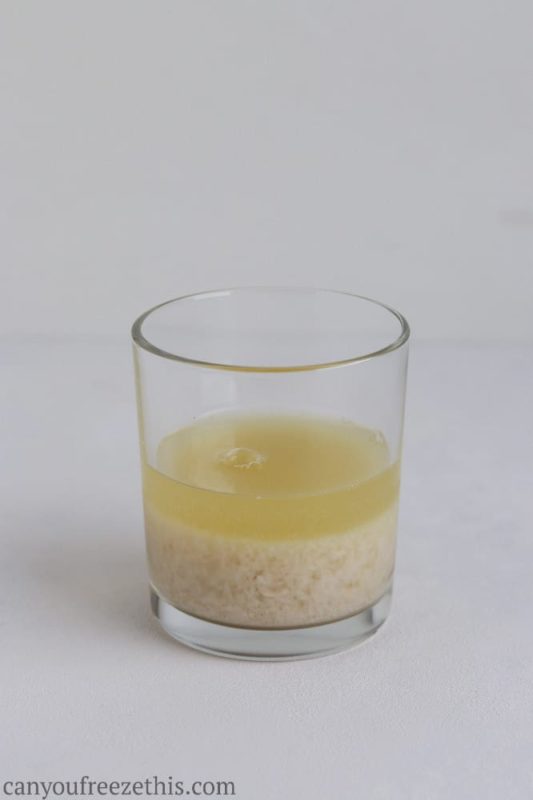
As you can see, the whole thing is separated and doesn’t even look similar to fresh almond milk.
Of course, you can read online that blending the thawed nut milk will fix the texture. Unfortunately, that’s only true to an extent.
Here’s what blended almond milk looks like:
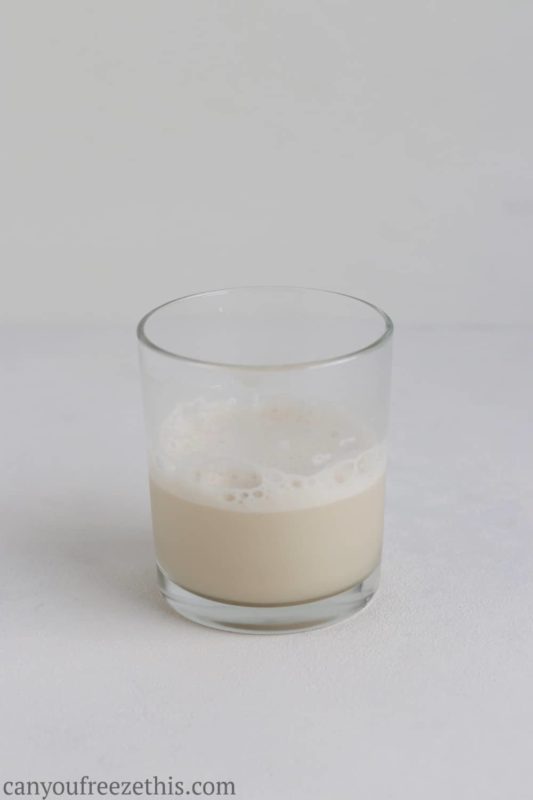
It looks much better, but you can still see a difference. Also, the thawed and blended milk tastes somewhat watery, and the texture isn’t even. Plus, there’s foam.
Here’s how the three compare:
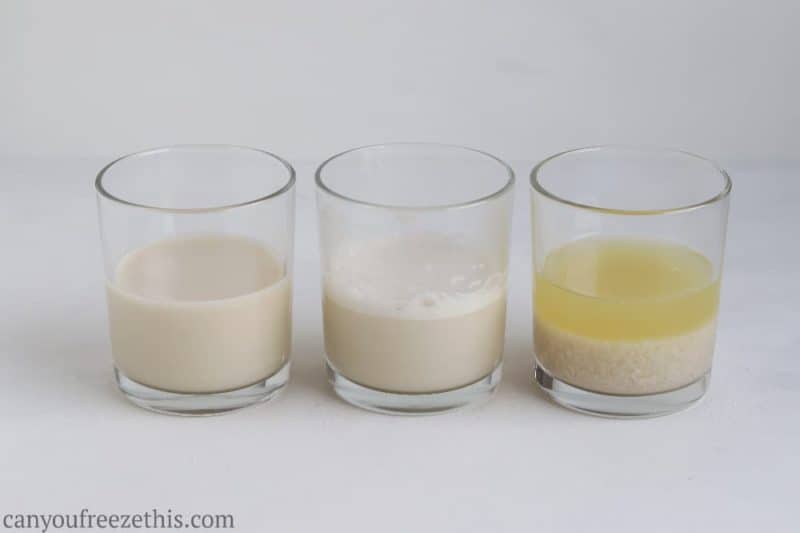
That means drinking it straight from the glass isn’t really an option, no matter how powerful your blender is. It’ll just taste bad.
But if you use it as a liquid base for smoothies, use some when prepping pancakes, or in any other cooked or baked dish, the thawed almond milk should work alright.
Almond milk from some brands freezes slightly better than from others. So if you really want to make this freezing project work (i.e., it’s not a one-time thing), freeze almond milk from different brands and pick the one that works best for you.
What About Homemade Almond Milk?
Freezing homemade almond milk works the same way freezing store-bought almond milk does. The nut milk separates after defrosting and needs blending before it becomes usable in cooked and baked dishes.
Knowing that, let’s talk about the freezing method.
How to Freeze Almond Milk
There are two popular options when it comes to freezing this vegan-friendly drink:
- using an ice cube tray
- in airtight container
If you don’t have set plans for the leftovers or would like the flexibility of thawing only a tiny amount, go with freezing it in an ice cube tray.
But if you already know how you’ll use the thawed almond milk, and those aren’t tiny portions you get in an ice cube tray, you can freeze it portioned in a container or multiple containers, depending on your needs.
While the first method requires a bit more hands-on time, it’s super-flexible and well worth the additional 5 minutes of effort.
Plus, you can use the thawed drink however you want. No need to worry that you’re thawing a large volume that you’ll have to use within a day or two.
The second one is great if you’re into planning. Portion the leftover almond milk into a couple of containers, each one enough for a recipe. Then, when you’re ready to use it, just pop the container in the fridge the night before.
In an Ice Cube Tray
- Take an ice cube tray and pour the milk into it.
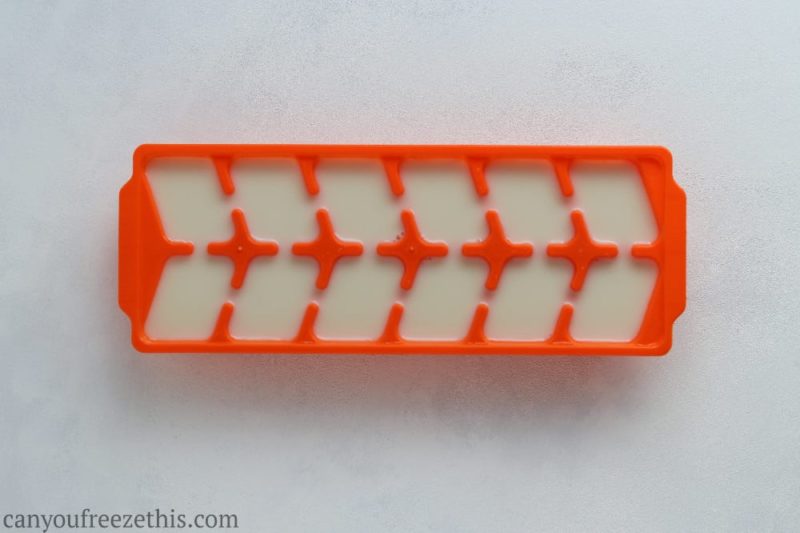
Almond milk in an ice cube tray - Put the ice cube tray in the freezer. Keep it there until the liquid freezes. Freezing should take only a few hours. I usually leave the trays overnight to be sure the milk freezes solid.
- Remove the almond milk cubes from the tray and transfer them into a freezer bag or container. If using a freezer bag, squeeze out as much air as possible before sealing. Work fast so the warmth of your fingers won’t thaw the milk. Label the bag or container if needed.
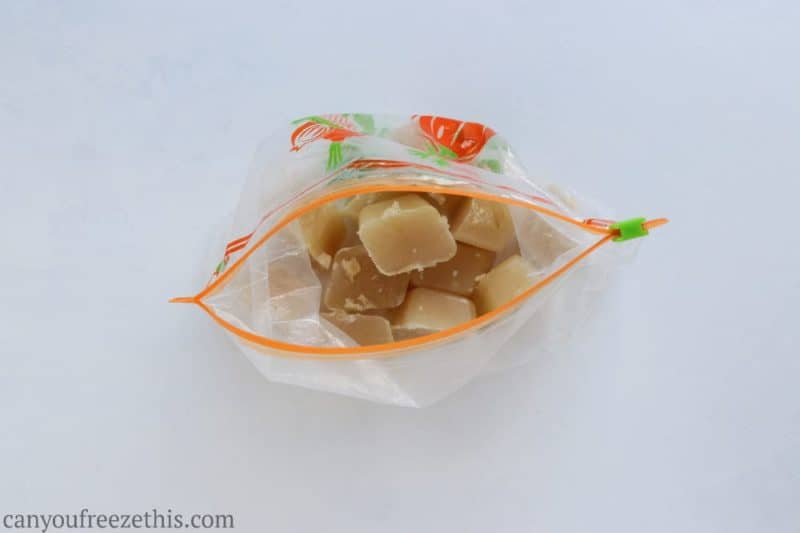
Frozen cubes of almond milk - Throw the packaged cubes back into the freezer.
In a Container
- Consider portion size. When thawing, you will thaw all the milk that’s in a container. So if you only need one cup at a time and have 3 cups worth of almond milk, freezing three one-cup portions is the smart thing to do. If you have no idea how much almond milk you will need at a time, consider freezing it in cubes.
- Pick containers. Almond milk consists mostly of water, so it expands when frozen. That means you need to leave some space in the containers used for freezing. If you would like to use the original carton or container, feel free to do so. Just make sure there’s space for the milk to expand (e.g., pour some of it out before freezing). Alternatively, you can use any freezer-safe airtight containers for freezing.
- Pour the milk into the containers. Label them with a name and a date if needed.
- Transfer the containers into the freezer.
Alternatively, if you want to limit how much space almond milk takes in your freezer, you can use freezer bags instead and freeze them flat. Just make sure you place each bag in a bowl before pouring the liquid into it so that if it’s leaky, there’s not that much cleanup to do.
Now that you have the lactose-free milk safely in the freezer, let’s talk about defrosting it.
How to Thaw Almond Milk
You can defrost almond milk:
- Overnight in the fridge. Put the almond milk cubes or container into the fridge in the afternoon or evening the day before you need it. It will be thawed and ready to use in the morning. If it’s a large container, you might need more time than those 12 – 16 hours, so plan accordingly. To speed things up, place the container or freezer bag with the cubes in cold water.
- Throw the frozen cubes in without defrosting. In many cases, you can throw the cubes without thawing them first. That works well for dishes you cook on the stove, or if you need some ice in your smoothie. When making muffins or pancakes, mix the cubes with the rest of the wet ingredients, and they’ll defrost in 10 to 20 minutes.
Now that you’ve thawed the lactose-free milk, you’re left with a grainy liquid that looks rather gross.
Something like this:

Blending it will make things much better, but not perfect. And no, giving it a good stir probably won’t cut it.
Use your defrosted almond milk within a day or two of thawing. Ideally, you would use all of it immediately after thawing, but that’s not always an option.
Next, let’s talk about using defrosted almond milk.
How To Use Thawed Almond Milk
Some popular ways of using thawed almond milk include:
- Smoothies. You can use frozen almond milk instead of ice cubes, or thaw the nut milk and use it as the liquid base.
- Cooking. Pancakes come to mind first, but anything that uses fresh almond milk (or regular milk or any other milk alternative) should work just fine too.
- Baking. Pies, cakes, and the like are great options.
Okay, so you’ve thawed some almond milk and, unfortunately, you have leftovers. Can you refreeze them?
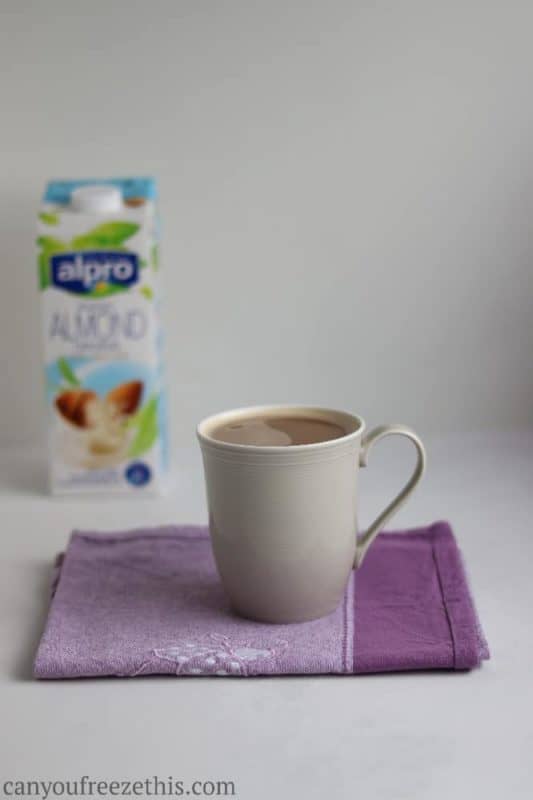
Can You Refreeze Almond Milk?
You can refreeze almond milk if you’ve defrosted it in the fridge. Blend the leftovers or at least give them a good stir, pour them into containers or an ice cube tray, and place them in the freezer.
Despite what many sites say about refreezing food, it’s generally safe if it was defrosted in the refrigerator and didn’t sit in the fridge for longer than a day or maybe two.
(Still not convinced? Check out our freezing FAQ for the details.)
So if you thawed almond milk in the fridge, refreezing the rest is an option. Please note that the additional freezing and defrosting won’t help the texture, but it won’t make the nut milk dangerous to your health or anything.
Instead, you’ll end up with almond milk that’s even more separated than what it was after the first freezing.
FAQ
Below we cover some of the more popular questions related to freezing this popular nut milk.
When it Makes Sense to Freeze Almond Milk?
Store-bought almond milk has a shelf life of at least a couple of months, so if the carton is still unopened, it usually doesn’t make sense to freeze it. Unless, of course, you are sure that you won’t use it for quite some time beyond the date on the label.
When it comes to homemade almond milk, if you’re preparing a bigger batch, it makes perfect sense to freeze some of it right away. The homemade variety lasts only a few days, and freezing is the way to go.
Can You Freeze Almond Milk in the Carton?
Ideally, you want to transfer the product to a freezer-safe container, but the carton it comes in is usually okay too. Make sure there’s room in the package, as almond milk expands when frozen.
In other words, chucking an unopened carton into the freezer is a big no-no. The carton will likely burst, the milk will spill, and you’ll have to spend the afternoon cleaning up the freezer.
Can You Freeze Alpro Almond Milk?
According to the brand’s official website, certain Alpro products are not meant to be frozen. A representative for Alpro said that the brand’s almond milk, in particular, should not be frozen.
Don’t let the fact that the brand doesn’t recommend freezing their product prevent you from experimenting with freezing it, though. As mentioned a few times, most brands don’t recommend freezing their almond drink, and people do it anyway.
Can You Freeze Smoothies Made With Almond Milk?
Generally, smoothies freeze well, but their thawed state will depend on the ingredients you’ve used. The quick answer is yes; you can freeze smoothies made with almond milk. Just make sure you are using freezer-safe containers.
Once you thaw the smoothie, the consistency may be a little watery. That goes especially for smoothies with almond milk.
You can restore the smoothie’s original consistency by running it through the blender once again and perhaps adding a bit of fresh almond milk to give it a better taste.
Can You Freeze Almond Milk for Smoothies?
Definitely, making smoothies is one of the best ways of using frozen almond milk.
If you want to stay flexible in how much almond milk you add, freeze it in an ice cube tray. But if you know upfront how much almond milk you need for a single smoothie, a container might be a better option for freezing.
When it comes to making the smoothie, you can either wait for the milk to thaw or throw it in frozen instead of the ice cubes in the recipe. Choose whatever works best for you.
Can You Freeze Almond Milk To Make Ice Cream?
Freezing almond milk results in frozen almond milk. (Well, duh.)
It’s just a block of ice with an almond-like taste, and definitely not ice cream. Adding some mashed fruit to the milk and freezing it won’t result in ice cream either.
Similarly to soy milk, you’ll need an ice cream maker or at least a high-speed blender to make ice cream with almond milk. If you have either, check out these almond milk ice cream recipes.
Can You Freeze Almond Milk Coffee Creamer?
Like almond milk, almond milk coffee creamer separates after being frozen and thawed. Getting back the texture you like will require giving it at least a good stir or running it through a blender. And it most likely won’t taste as good as fresh.
Can You Freeze Almond Milk Yogurt?
Like regular yogurt, freezing almond yogurt is okay, but separation will occur after thawing.
Texture and consistency will be altered, confirms the Amande website. That means it would be best to use frozen and thawed almond yogurt only in cooked or baked recipes, where the texture change won’t be noticeable.
Eating it plain after thawing won’t be nearly as pleasant as eating it fresh.
About the Author

Marcin is the managing editor of CanYouFreezeThis.com. He is making sure all the freezing info on this page is accurate and the posts easy to digest and use.